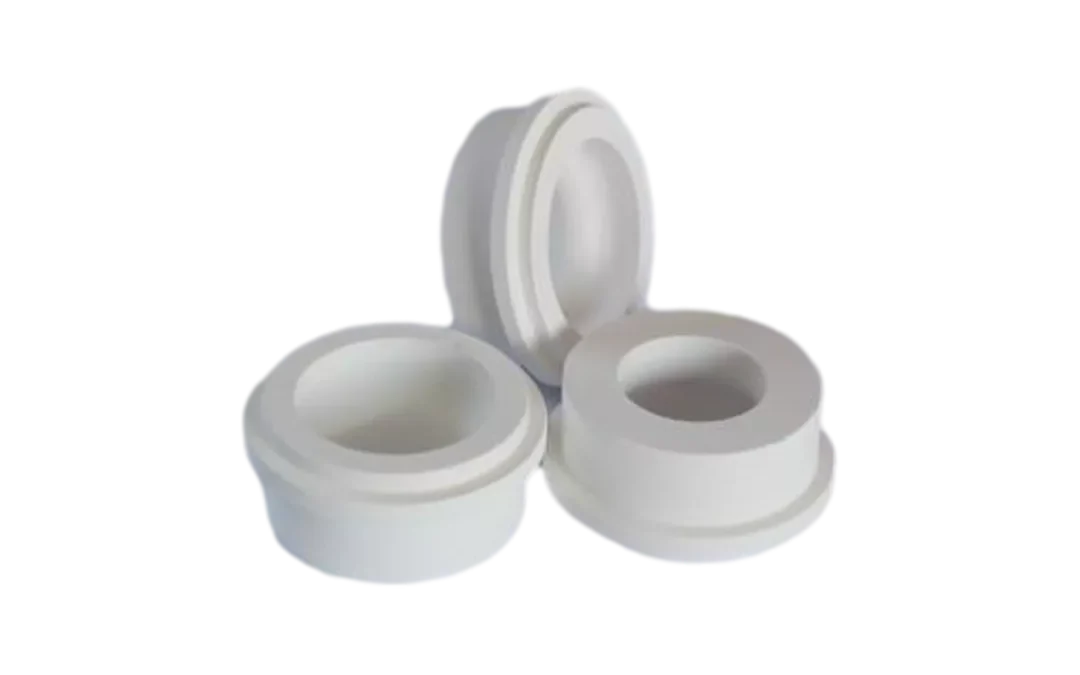1. The influence of additives on the structure and properties of aluminum titanate refractory:
Aluminum titanate refractory
Advantages: high melting point, low expansion, etc.
Disadvantages: low strength, easy to decompose, difficult to sinter, etc.
The low expansion of aluminum titanate refractory is based on microcracks, and excessive microcracks will inevitably lead to low strength. In order to maintain low expansion of the material while having considerable strength, the size and number of cracks must be controlled within a certain appropriate range. To this end, the intrinsic thermal expansion coefficient of Al2TiO5 must be reduced, its anisotropy must be reduced, and the grain domain size must be controlled. The introduction of additives can effectively inhibit the growth of particle size and change the properties of aluminum titanate materials.
MgO is the most commonly used additive in the preparation of aluminum titanate refractory. MgO dissolves and replaces Al2O3 in Al2TiO5, and increases the lattice constant of Al2TiO5.
According to the relationship curve between the amount of MgO added and the lattice constant of Al2TiO5, the solid solubility limit of MgO in Al2TiO5 is 25% (mass fraction). Excess MgO reacts with the replaced Al2O3 to form spinel.
It and the replaced aluminum oxide exist on the grain boundaries, hindering the growth of Al2TiO5 grains, weakening the domain structure, reducing grain boundary cracking, promoting material sintering, and facilitating the strengthening of synthetic materials. For Al2TiO5, magnesium oxide is also a good stabilizer. 5% (mass fraction) MgO can make Al2TiO5 undergo 1100℃, 9h heat treatment without decomposition.
An appropriate amount of MgO can not only partially or completely control the thermal decomposition of aluminum titanate porcelain, but also improve the mechanical properties of the porcelain, and has little effect on other excellent thermal properties of the porcelain. The addition of magnesium oxide will slightly increase the thermal expansion coefficient of the material, but it is still lower than other materials.
Fe2O3 is considered to be one of the best additives. When Fe2O3 is used as an additive, it reacts with TiO2 at around 1100℃ to form Fe2TiO5, and can react with Al2TiO5 above 1350℃ to form a solid solution. The presence of Fe2O3 can act as a catalyst for the formation of aluminum titanate, accelerate the formation of aluminum titanate, and reduce the synthesis temperature.
In the process of preparing aluminum titanate ceramics using synthetic Al2TiO5 powder as raw material, the introduction of ZrO2 can significantly improve the structure and performance of the material. The addition of ZrO2 can increase the strength of aluminum titanate refractory materials, while having little effect on the excellent thermal properties of aluminum titanate.
SiO2 has a dual role: one is to react with part of Al2O3 to form mullite for reinforcement; the other is to replace part of A3 in aluminum titanate to form a solid solution in the following form and generate vacancies, inhibiting the decomposition of aluminum titanate during cooling through a temperature range of 800-1300°C, so as to achieve the purpose of stabilizing and increasing the content of aluminum titanate.




2. The influence of process conditions on the structure and properties of aluminum titanate:
As early as 1952, Lang et al. reported on the thermal decomposition of Al2TiO5. He pointed out that the compound has two crystal forms, 1820-1860℃ high temperature type, 1300-1820℃ and room temperature-800℃ low temperature type, unstable at 800-1300℃ and easily decomposed into rutile and corundum.
In 1971, Bayer et al. pointed out that the thermal instability of Al2TiO5 is not only related to its temperature, but also to the grain size and purity of the material. Later, Kato, Kameyama et al. further studied the decomposition reaction of Al2TiO5 and concluded that the reaction is a nucleation and growth process, and its reaction rate is affected by the following factors.
Kato heat-treated the different fineness powders obtained by ball milling the synthetic Al2TiO5 powder for different times at 1120℃ and found that the finer the powder, the easier it is to decompose.
However, if the powders of various finenesses are heat treated at 1310℃ for 5h before thermal decomposition experiments, it is found that the decomposition rate of various powders decreases, and the finer the powder, the more difficult it is to decompose.
Kato attributed this phenomenon to the influence of grinding and heat treatment on the crystal structure, that is, the finer the powder before pretreatment, the more defects it has inside and on the surface, and the decomposition reaction is easy to nucleate and thus more intense;
During pretreatment, due to the heat treatment process of fine crystals, ions are easy to rearrange to reduce crystal defects and reduce internal stress, thereby eliminating as many active points of decomposition reaction as possible, and the decomposition reaction rate decreases at this time.
The degree of microcracking of aluminum titanate refractory materials is greatly dependent on the grain size. There is a critical grain size that can spontaneously form microcracks. When the grain size is larger than the critical size, microcracks will spontaneously form at the grain boundary, and its grain size is related to the firing temperature.
When the firing temperature is low, the critical grain size is larger and the microcracks are relatively fewer; when the firing temperature is high, the critical grain size is lower, the grains grow larger, and microcracks are more likely to form, resulting in reduced mechanical strength and a smaller thermal expansion coefficient.
If you have any needs about industrial ceramic materials, please feel free to contact us at any time 0086-17702411651

